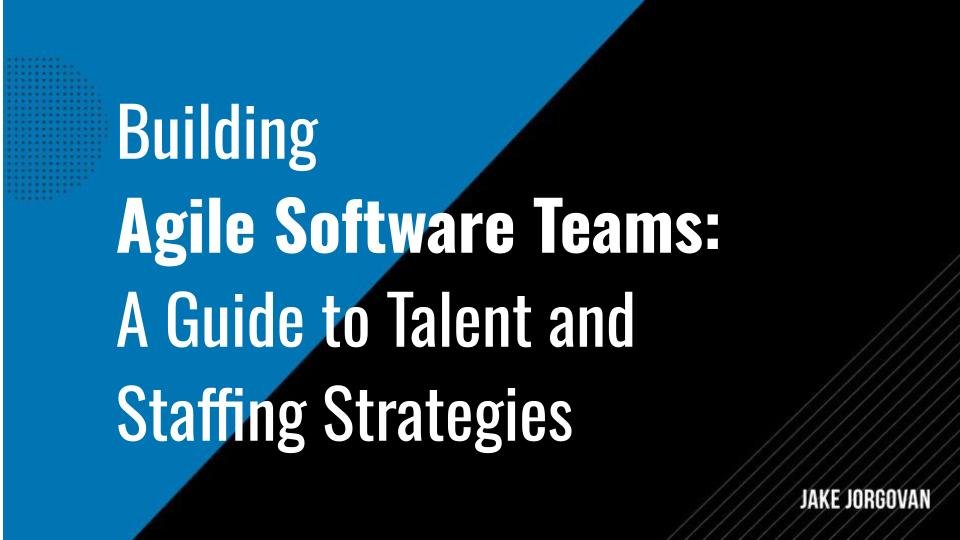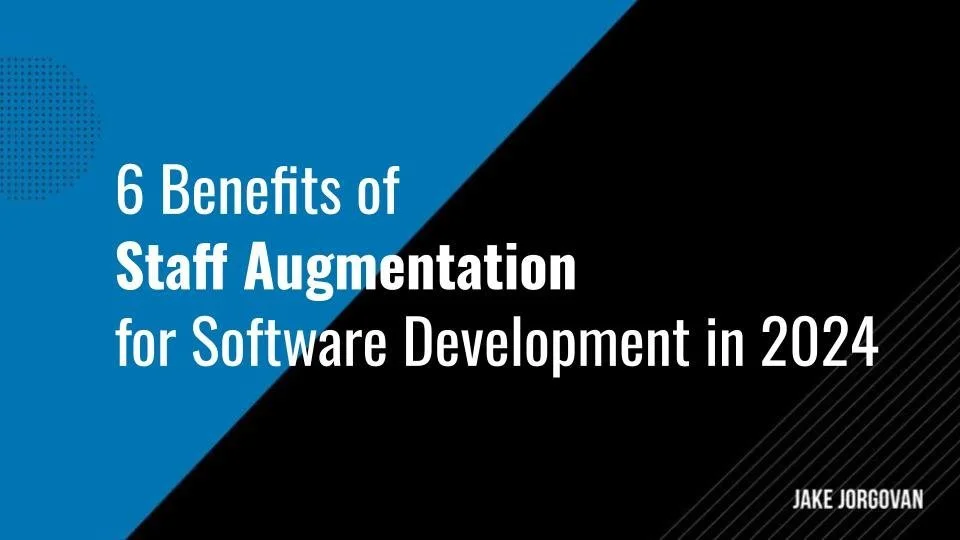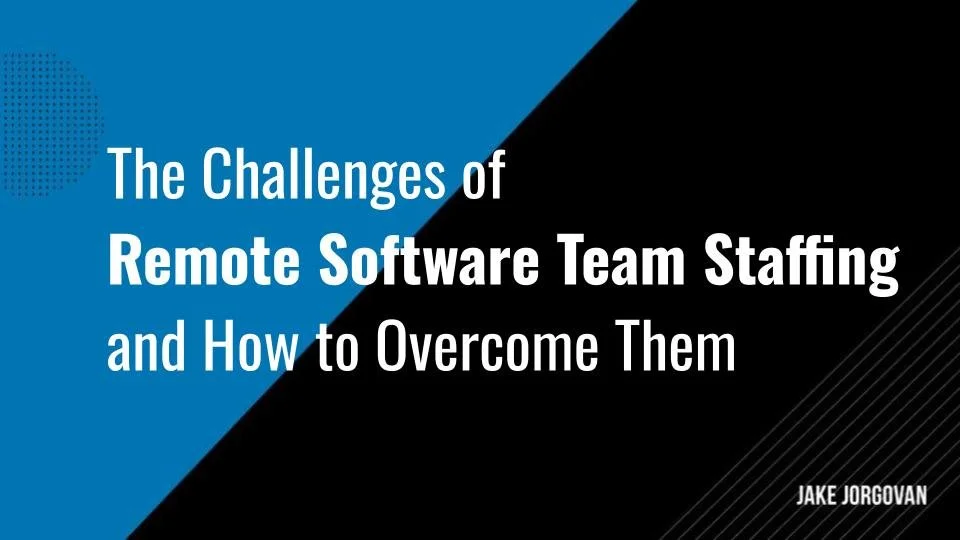Building Agile Software Teams: A Guide to Talent and Staffing Strategies
In the fast-paced world of software development, agility is not just an advantage—it's a necessity.
Yet, building an Agile software team that thrives on change and delivers results consistently remains a massive challenge for most staffing agencies.
If you're struggling to find and retain the right talent for your Agile team, you're not alone.
This guide will improve your Agile talent and staffing strategies, ensuring you can engage and retain top software talent. Here’s what you can expect:
Understanding Agile Principles: Discover the core Agile principles underpinning effective team dynamics.
Talent Acquisition for Agile Teams: Learn how to identify and attract candidates who excel in an Agile environment.
Structuring Agile Teams: Find out the optimal compositions and roles crucial for Agile success.
Fostering an Agile Culture: Explore strategies to nurture a culture that embodies Agile values and practices.
Managing Agile Teams: Gain insights on leadership styles and conflict resolution for Agile team management.
Scaling Agile Practices: Tackle the challenges of applying Agile methodologies in large-scale operations.
Keep reading to master the art of building and managing high-performing Agile software teams.
Defining Agile Methodology and Its Impact on Software Team Effectiveness
Agile methodology is a project management approach that emphasizes flexibility, continuous improvement, and customer satisfaction through iterative development.
In this framework, cross-functional teams collaborate on tasks in short cycles known as sprints, enabling rapid response to change and frequent delivery of value to customers.
What that means for you: Building Agile software teams can be paramount for your business, as their adaptability and cohesion directly impact project success and innovation.
Agile teams possess a blend of technical expertise, communication skills, and a shared commitment to Agile principles. Thus, they can efficiently tackle the complexities of software development.
This alignment accelerates product development and enhances the ability to meet customer needs precisely and promptly, sustaining your competitive advantage in a dynamic market.
Understanding Agile Principles
Agile principles prioritize customer satisfaction through early and continuous delivery of valuable software. Even late in development, teams embrace change to enhance customer competitive advantage.
Besides, daily cooperation between business stakeholders and developers ensures alignment and rapid feedback.
Self-organizing teams are also central to Agile, with members given autonomy to design solutions, fostering innovation and accountability.
Traditional project management, in contrast, follows a waterfall model: sequential, with fixed phases and rigid structures, leading to a slower response to change.
Here’s how that looks in practice:
For example, in Agile, a software development team might adjust features based on ongoing user feedback, whereas in traditional settings, the feature set is defined upfront and altered minimally. This flexibility in Agile allows for more fluid adaptation to market shifts and customer needs, demonstrating its strength in dynamic environments where user requirements evolve rapidly.
Role of Staffing Agencies in Sourcing Agile Talent
Staffing agencies can be valuable partners in building high-performing agile teams.
Hint: You just have to pick a solid staffing agency with:
An extensive network: This network allows them to tap into a wider pool of qualified candidates with the specific technical skills and agile mindset needed for success.
Expertise: Good staffing agencies have experience pre-screening candidates based on cultural fit and experience working in agile environments.
This streamlines the recruiting process for your internal teams, allowing them to focus on interviewing and selecting the best fit for their specific needs.
Insider tip: Staffing agencies can offer flexible staffing solutions, such as temporary or contract placements, to help fill short-term needs or scale teams up or down during different project phases.
How to Do Talent Acquisition for Agile Teams
Finding the perfect fit for agile teams requires a targeted approach.
This section dives into key characteristics to seek in candidates, along with effective recruiting and evaluation techniques to build high-performing agile units.
Agile Candidate Characteristics
A solid candidate for your Agile team must have the following characteristics and skills:
Technical Proficiency: Deep expertise in the relevant technologies and frameworks used by the team
Agile Mindset: Ability to thrive in a fast-paced, iterative environment focusing on continuous improvement
Collaboration: Strong communication and interpersonal skills to foster teamwork and knowledge-sharing
Problem-Solving: A knack for tackling complex challenges creatively and adapting to changing priorities
Self-Motivation: Initiative and ownership to deliver results without constant oversight
Agile Recruiting Strategies
The most effective recruiting strategies for an Agile team include:
Targeted Sourcing: Leverage online communities, developer platforms, and professional networks specific to the team's technical stack.
Skills-Based Assessments: Use technical coding challenges and scenario-based interviews to assess practical capabilities.
Agile Interview Practices: Incorporate collaborative exercises and whiteboarding sessions to evaluate teamwork and problem-solving skills in an agile context.
Evaluation Techniques
After you find the right candidates, it’s time to evaluate them. Here’s what to consider:
Peer Interviews: Involve current team members in the interview process to assess cultural fit and technical alignment.
Take-Home Assignments: Assign realistic, project-like tasks to evaluate a candidate's ability to work independently and produce high-quality deliverables within a defined timeframe.
Reference Checks: Contact past employers and colleagues for insights into the candidate's work ethic, collaboration style, and contributions in a previous agile environment.
By focusing on these characteristics and implementing targeted recruiting and evaluation strategies, you can build Agile teams with the skills, mindset, and collaborative spirit necessary to thrive in a fast-paced and ever-evolving development environment.
How to Structure Agile Teams
Recruiting the right people for agile teams is just the first step.
You should also structure the team correctly if you want it to work in unison. That’s why you should consider the factors below.
Set the Team Size and Composition
Agile teams are known for their focus on speed and efficiency. The optimal size typically ranges between 5 and 9 members, ensuring clear communication and fostering a collaborative environment.
Composition should be cross-functional, with individuals possessing the necessary skills to complete all aspects of a user story within a sprint cycle.
This may include:
Developers: Full-stack, front-end, back-end, or specialists, depending on project needs. Responsible for building, testing, and deploying functionalities.
Product Owner: This person is the voice of the customer. They prioritize the product backlog and ensure the team delivers valuable features.
Scrum Master: Facilitates agile ceremonies, removes roadblocks, and coaches the team on best practices.
Consider Additional Roles (Optional)
UX/UI Designer: Focuses on user experience and interface design.
Business Analyst: Provides domain expertise and translates business requirements into user stories.
QA Tester: Ensures the quality of developed features through manual and automated testing.
The specific team structure can be adapted based on project complexity and team expertise.
Case Study Break: Spotify
Agile structuring is exemplified in a case study from Spotify, where they adopted a model with squads (small cross-functional teams), tribes (groups of squads), chapters (people with similar skills), and guilds (interest-based communities).
This structure promotes autonomy and alignment with the company's goals while supporting knowledge sharing and innovation.
The Spotify Agile model isn't a one-size-fits-all solution, primarily because it's tailored to Spotify's unique culture and needs. When other organizations try to adopt it wholesale, they may encounter issues due to differences in their own contexts, such as company culture, size, and goals.
Insider tip/ warning: Don’t try to apply the exact same model to your company; instead, think of a scalable Agile framework that adapts to your organization's size and market dynamics.
Foster an Agile Culture
Fostering an Agile culture requires creating an environment where collaboration, transparency, and customer focus are paramount.
This setting encourages teams to share knowledge freely, experiment without fear of failure, and adapt to change rapidly.
Here’s what to consider if your staffing agency offers post-hire placement support:
Promote Agile values: Techniques to promote Agile values include regular retrospectives for continuous improvement, daily stand-ups to enhance communication, and pairing sessions for skill sharing and mentoring.
Emphasize a fail-fast mentality: This approach allows teams to learn from mistakes and innovate more effectively.
Embed Agile coaches: Coaches can further instill Agile practices, guiding teams through the nuances of methodology and mindset shifts. Ensure your coach celebrates successes, both big and small, to reinforce the value of Agile achievements and motivate your teams.
Create cross-functional teams: This approach breaks down silos, ensuring a diverse mix of perspectives and expertise. And this diversity of minds is vital for addressing complex problems.
This deliberate cultivation of an Agile culture empowers teams to deliver high-quality software that meets evolving customer needs efficiently.
Train and Develop an Agile Team
If your staffing agency offers onboarding support, suggest continuous learning and improvement for your Agile candidates. These are foundational to Agile's ethos, ensuring teams remain competitive and responsive to change.
Investing in training and development sharpens skills and deepens understanding of Agile methodologies.
So, let’s see some practical ways to achieve that:
Programs like Certified Scrum Master (CSM) and SAFe Agilist (SA) offer structured learning paths, equipping individuals with the knowledge to navigate Agile environments effectively.
Technical workshops in areas like test-driven development (TDD) or pair programming enhance practical skills.
You can adopt internal training sessions, Agile coaching, and mentorship programs to foster a culture of continuous improvement. Online platforms like Coursera and LinkedIn Learning provide accessible resources for ongoing education in Agile practices.
These initiatives boost individual capabilities and enhance team performance, leading to more innovative and customer-focused solutions. Regularly updating and expanding Agile competencies ensures teams can handle your evolving project demands and industry trends.
Manage Agile Teams
Managing Agile teams effectively starts with understanding leadership style and team dynamics. Your staffing agency may get involved in this step if you’re bringing in more candidates to create an entire team or if you’re bringing in an executive candidate.
Leadership Style
Agile teams flourish under servant* leaders who empower the team, remove roadblocks, and foster a collaborative environment. Leaders should provide clear vision and goals but delegate decision-making and execution to the team, promoting ownership and accountability.
*Yes, servant leadership is an actual concept; we’re not using fancy words.
Here’s an in-depth video that can help you understand this concept better – it’ll help you build a better Agile team.
Let’s summarize:
Empowerment: Providing clear vision and goals while trusting teams to make tactical decisions and own their work.
Coaching and Facilitation: Offering guidance and support to remove roadblocks and enhance team performance.
Focus on Outcomes: Prioritizing delivering value iteratively over micromanaging individual tasks.
Team Dynamics and Conflict
To streamline team dynamics and tackle conflict better, you need a three-pronged approach:
Open Communication: Encourage open dialogue and active team listening to address issues proactively.
Retrospectives: Regularly use retrospectives as a safe space for team members to discuss challenges, propose solutions, and build stronger working relationships.
Focus on Solutions: When conflicts arise, prioritize solutions over blame. Facilitate discussions to identify root causes and implement preventive measures.
By adopting a servant leadership style and fostering open communication within the team, you can effectively manage team dynamics and conflicts, ensuring a smooth and productive agile workflow.
Scale Agile Practices
Scaling Agile in large organizations presents challenges such as aligning multiple teams, maintaining Agile principles across departments, and ensuring consistent practices.
Many staffing agencies don’t get involved in this step; however, you may offer this service, especially if you want to integrate your candidates into the companies’ cultures.
So, integrating Agile at scale requires addressing the complexity of larger product ecosystems and coordinating numerous interconnected projects.
Frameworks for scaling Agile include:
SAFe (Scaled Agile Framework): Offers a structured approach for aligning Agile development with business goals, facilitating collaboration across large teams, and managing complex portfolios.
LeSS (Large-Scale Scrum): Extends Scrum principles to larger organizations, focusing on simplicity and defining clear roles and processes for scaling.
DaD (Disciplined Agile Delivery): Provides a comprehensive toolkit that guides organizations through Agile adoption and tailors practices to specific business needs.
Insider tip: Each framework addresses the unique challenges of scaling Agile. Select the right framework according to the organization's size, culture, and specific project requirements.
Measure Success in Agile Teams
Measuring success in Agile teams involves monitoring specific key performance indicators (KPIs) that reflect the team's efficiency, productivity, and alignment with project goals:
Velocity: Tracks the amount of work a team completes during a sprint, gauging productivity and forecasting future performance
Sprint Burndown: Measures the work remaining in a sprint, indicating whether the team is on track to complete tasks on time
Lead Time: Calculates the time from task conception to completion, providing insight into process efficiency
Cycle Time: Assesses the time taken to complete a task, highlighting areas for process improvement
Customer Satisfaction: Gauges client feedback and satisfaction with the delivered product, ensuring the team's output meets user needs
Insider tip: Tools and methods for tracking these KPIs include Agile project management software like Jira, Trello, and Asana, which offer dashboards, reporting features, and analytics to monitor project progress and team performance.
These tools facilitate real-time tracking and visual representation of data, enabling your teams to make informed decisions and adjustments promptly. And this real-time adaptation aligns closely with Agile's iterative and responsive nature.
Agile Methodology in Action: Case Studies from Siemens, Cisco, Google, and Mitsubishi
In exploring case studies of Agile software teams, we uncover diverse experiences from global companies that have successfully implemented Agile methodologies to address specific challenges, foster innovation, and significantly improve operational efficiency.
Siemens' Agile Transformation: A Leap Towards Collaborative Excellence
One notable example is Siemens' Digital Factory division, which adopted Agile to develop software automation systems. This initiative, aimed at enhancing collaboration and efficiency, resulted in improved morale and a culture more aligned with iterative and incremental approaches within just two weeks of implementation.
Cisco's Agile Revolution: Enhanced Transparency and Team Empowerment
Cisco's experience with the Agile implementation for its Subscription Charging Platform illustrates the benefits of daily alignment meetings and the SAFe framework, leading to enhanced transparency and self-management among teams. This case highlights the importance of accountability and clear communication in Agile environments.
Google's Agile Edge: Flexibility and Innovation in Adwords Development
At Google, Agile methods, particularly the Scrum framework, have been pivotal in developing and testing key projects like Google Adwords. This approach has allowed for flexibility in technology and method application, underscoring Agile's adaptability to different project requirements.
Mitsubishi's Agile Odyssey: Scaling Agile Across Diverse Sectors
Mitsubishi's journey with Agile began with a focus on integrating Agile practices across its diverse operations in aerospace, semiconductors, power generation, and more. Through workshops and active employee involvement, Agile methodologies were gradually adopted, demonstrating the potential for Agile to scale across various departments and geographical locations.
These case studies underscore the versatility and effectiveness of Agile methodologies in fostering a culture of continuous improvement, adaptability, and customer-centricity.
Remember the importance of leadership support, fostering a collaborative and innovative culture, and the strategic implementation of Agile practices tailored to your organization's specific needs. Do it right, and you get a robust framework for enhancing productivity, reducing costs, and improving product quality and customer satisfaction.
Navigating the Future: Embracing Agile Teams in Software Development
This guide has armed you with the insights needed to build and manage an Agile team, which is essential for staffing firms looking to develop Agile software teams.
Looking ahead, Agile teams and methodologies will continue to evolve, adapting to technological advancements and changing market demands.
This evolution promises more refined approaches to project management and team collaboration, ensuring Agile remains at the forefront of efficient and effective software development.
And you’ll need to adapt to all that.
But with the right strategies and understanding of Agile principles, you're well-equipped to assemble a team that's not just ready for the future but capable of shaping it.

























